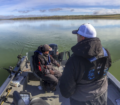By Steve Weisman
Finally, we get a break from daily rains. It certainly is something for which our farmers have been longing! Plus, it gives a chance for the rivers to get back in their banks and for our lakes to catch up.
At the Iowa Great Lakes, we have been hoping that the water levels would begin to recede, and as of Sunday, June 2, it began to happen. It’s a slow process, though, just a fraction of an inch at a time. There is an incredible amount of water flowing through these lakes, which is understandable when you are dealing with a watershed of over 90,000 acres!
I’ve been following the Dickinson County Emergency Management website, where I can quickly see what the lake and river levels are and also look at what the previous seven days have been.
This is what I found on Sunday.
First, these were Big Spirit’s numbers. It was 14.6 inches above the spillway. This is 7.6 inches below the emergency no-wake 5 mph rule.
Next, the Okoboji chain with the gauge at Lakeside Lab. The water was 23.2 inches above the outlet. That level is precariously close at only 2.8 inches below the emergency no-wake 5 mph rule. A good rain, especially at the northern edge of the Iowa Great Lakes Watershed would probably put the level above the no-wake mark.
The process to the no-wake
Why the no-wake? The answer is really pretty simple: to protect the shorelines by establishing thresholds and emergency rules for boat speed on Dickinson County lakes during high water events. Major flooding has occurred in 1993 (the worst in history) 2011 and again in 2018. In looking at the high-water plan, it is obvious that the Dickinson County Emergency Management Commission has looked at all the options before making this decision. The plan reads as follows: “The Commission fully understands the impact an emergency rule could have on local businesses and tourism revenue. This plan was developed through input from local leaders and communities to balance lake use with shoreline and infrastructure protection.”
Last summer’s initial plan included a 600-foot no wake rule before the total no wake rule went into effect. The 600-foot no wake was difficult to determine and was a pain for law enforcement, so on January 8, 2019, the plan was amended to simply go to the total no wake rule. Again, this amendment was made to incorporate enforcement concerns from the Department of Natural Resources, input from various lake associations and local businesses.
When is the no-wake rule relaxed?
The emergency 5-mph rule will be lifted when water levels fall below the implementation water level at both gauge sites for 72 hours.
Public Notification
So, how do we find out? This is how public notification reads: The Emergency Management Commission will work to notify the public when emergency rules are in effect. Methods will include signs at boat ramps, local radio and television stations, newspapers, websites, social media and any available mass notification systems. In addition, the Commission will notify the cities and area Chamber of Commerce and tourism offices.
The answer to this entire issue is to not get any rain for a while and let the water levels go down. We have a long summer ahead of us, and I think we can remember what happened in early July of 2018. Let’s hope we can ease our way out of this situation and get back to normal water levels.
















